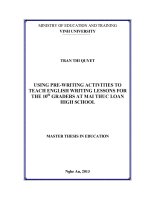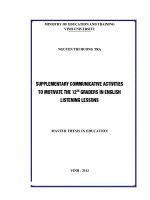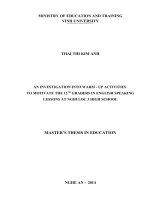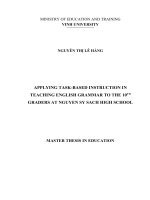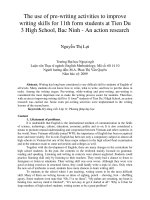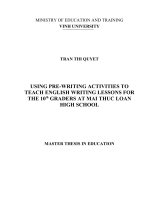Activities to motivate the 12th form students’ learning in revision classes for the gcse examination at thach thanh 3 high school
Bạn đang xem bản rút gọn của tài liệu. Xem và tải ngay bản đầy đủ của tài liệu tại đây (209.47 KB, 19 trang )
SỞ GIÁO DỤC VÀ ĐÀO TẠO THANH HOÁ
TRƯỜNG THPT THẠCH THÀNH 3
SÁNG KIẾN KINH NGHIỆM
ACTIVITIES TO MOTIVATE THE 12TH FORM STUDENTS’
LEARNING IN REVISION CLASSES FOR THE GCSE
EXAMINATION AT THACH THANH 3 HIGH SCHOOL
Người thực hiện: Hà Thị Lý
Chức vụ: Giáo viên
SKKN thuộc lĩnh vực : Tiếng Anh
THANH HOÁ NĂM 2017
CONTENTS
I. INTRODUCTION
1.1. REASONS FOR CHOOSING THE RESEARCH
1.2. AIMS OF THE RESEARCH
1.3. SCOPE AND OBJECT OF THE RESEARCH
1.4. RESEARCHING METHOD
II. MAIN CONTENT
2.1. THEORETICAL BACKGROUND
2.1.1. Definition of motivation
2.1.2. Strategies for motivating students in classroom
2.2. THE SITUATION OF TEACHING AND LEARNING
BEFORE THE APPLYING OF THE RESEARCH
2.3. ACTIVITIES TO MOTIVATE STUDENTS IN
REVISION CLASSES
2.3.1. Using the first lesson for needs analysis and goal setting.
2.3. 2.Changing ways for managing each lesson.
2.3.3. Changing ways for assessing students.
2.4 RESULT AFTER APPLYING THE RESEARCH IN TEACHING
III. CONCLUSION AND SUGGESTION
3.1. CONCLUSION
3.2. SUGGESTIONS
REFERENCE BOOKS AND QUOTATIONS
2
3
1.1. REASONS FOR CHOOSING THE RESEARCH
Passing the GCSE examination is the most important goal of all high school
students after such a long studying period of 12 years. In the school year of
2017, this is becoming more and more important and challening as the
ministry of education has officially decided to merge the GCSE and the
entrance examination to university into one. The new way of changing has
put students under a lot of pressure. However, during the first few times
teaching and helping students to revise for the GCSE, I had many
frustrations because I often found many of my students were not motivated
in class. There were always students absent from class, and even for
those who came to class, some of them were often absent-minded, and some
would even doze off in class. Later, after talking with some of the students,
I realized that students found the class boring and didn’t feel they had
learned much in class. Since most students had access to the teacher’s book
from which they could get the answers and background information for all
the materials we used in class, they didn’t feel it necessary or important to
be attentive in class. Frustrated by such feedback from my students, I
decided to introduce some changes into my lessons so as to motivate my
students.
1.2. AIMS OF THE RESEARCH
- To introduce some activities in revision classes to motivate students
in learning to prepare for the GCSE examination.
1.3. SCOPE, OBJECT OF THE RESEARCH
- Scope : Researching in the process of teaching revision lessons for the
GCSE English at Thach Thanh 3high school.
4
The study focused on 122 12
th
graders from the classes 12A4,
12A6, 12A7 at Thach Thanh 3 high school
- Object: This subject is concerned with ways of organizing activities in the
revision class.
1.4. RESEARCHING METHOD: Reading reference books , discussing
with other teachers, applying in teaching, observing and drawing out
experiences.
II. CONTENT
2.1. THEORETICAL BACKGROUND
In order to solve the problem, I set myself two tasks for a literature
review: finding out what is motivation and what are the strategies that a
teacher can use to motivate their students; and how those strategies have
been integrated into revision classes.
2.1.1. Definition of motivation
Research has found that motivation is concerned with both a person’s
behavior in carrying out a task and the reasons for carrying out that task
(Maehr & Meyer, 1997). In terms of behavior, it is a kind of “personal
investment” which is reflected in the “direction, intensity, persistence and
quality of what is done and expressed” (Maehr & Meyer, 1997, p.373). In
terms of underlying reasons, motivation is concerned with “why anyone
does or does not invest in any particular activity” (Maehr & Meyer,
1997, p.380). Many motivational constructs have been identified that are
believed essential in influencing people’s personal investment, such as
task-oriented /ego-oriented goals, attributions about past success or failure,
perceived self-efficacy, etc. (Cf. Dornyei, 2001). These constructs have
supplemented the traditional social approach of intrinsic/extrinsic
motivation in language learning (Gardner & Lambert, 1972).
5
2.1.2. Strategies for motivating students in classroom
Researchers have found that both individual factors, such as interest in the
subject matter, perception of its usefulness, general desire to achieve, selfconfidence and self-esteem, as well as patience and persistence (e.g., Sass,
1989), and situational factors, such as those aspects of the teaching
situation that enhance students’ motivation, may affect a given student's
motivation to learn (Dornyei & Csizer 1998; Lucas, 1990; McMillan &
Forsyth, 1991; Sass, 1989). The two sets of factors actually interact with
each other and work together to influence student motivation in the
classroom, as the interaction paradigm suggests (Maehr & Meyer, 1997).
Being very much concerned with what a teacher can do in classroom to
enhance student motivation, I focused mainly on situational factors, which
primarily fall into the following three aspects.
It has also been found that if teachers can make students active
participants in learning, students will be motivated to learn (Lucas, 1990).
More specifically, it is concerned with the quality of classroom activities
and the way these activities are presented and administered. It is suggested
that the teaching materials should have relevance to the learning goals and
be of appropriate difficulty level to the students concerned, a variety of
learning tasks should be presented properly with realistic goals and
effective strategies in reaching those goals, and students need to complete
those tasks by doing, making, writing, solving, creating rather than just
passively listening (Ames, 1992; Dornyei & Csizer, 1998; Lucas, 1990;
McMillan & Forsyth, 1991; Sass, 1989). When students find a learning task
interesting, engaging, meaningful, and useful, they tend to be highly
motivated to carry it out.
In addition, it has been found that if teachers can provide students with
6
opportunities to see their own progress and experience successes, students
will gradually build up their self-confidence and be more willing to work
hard (Dornyei & Csizer, 1998; Frosyth & McMillan, 1991). More
specifically, teachers may first set realistic expectations for their students,
then assign tasks that are neither too easy nor too difficult, and finally
give timely and informative feedback that supports students’ beliefs that
they can do well and help them see their own progress. In this way,
students will gradually build up their self-confidence and be more willing to
continue to work hard (Dornyei & Csizer, 1998; Frosyth & McMillan,
1991; Stipek, 1988).
2.2. THE SITUATION OF TEACHING AND LEARNING BEFORE
THE APPLYING NEW WAYS OF TEACHING.
This is the seventh year I have helped students to do some preparations for
the GCSE exams. By my experience of teaching and through discussing with
other teachers who are doing the same job as mine, I found that revision
classes were often boring to both the teachers and the students. The after
revision classes seemed to repeat the one before as the teacher gave some
exercises, questions or tests and students were forced to deal with them in a
fixed time. The teachers then gave feedback and asked students to remember
some skills that might help them in the real GCSE exams. Most students
expressed that they felt really tired and they could’t concentrate on what
they are doing. More than 70% of the 12 th form students agreed they didn’t
like sitting in revision classes. The only reasons for them to attend those
classes are to meet their parents’wishes as well as to follow the school’s
curriculum. Despite the teachers’ efforts, the students seemed not pay
attention and started creating noisy chatting classes. Sometimes, the
classroom happened to be a bedroom because many students dozed off .
7
Although my colleagúe and I have confronted a number of difficulties, one
of which was students’ lack motivation. The following table show the
students’performance before my changes in teaching:
Điểm khaỏ sát THPT QG lần 1
lớp
Sĩ
số
Trên 7 điểm
Từ 5.2 đến
7điểm
Từ 3 đến 5
điểm
SL
%
SL
SL
12A4
41
1
2.6%
5
12A6
42
1
2.4%
6
12A7
39
0
0%
3
%
12.1
%
14.2
%
7%
10
9
8
%
24.3
%
21.4
%
21%
Từ 1,2 đến 3
điểm
Nhỏ hơn
hoặc bằng 1
diểm
SL
%
SL
%
25
61%
0
0%
26
62%
0
0%
27
69%
1
3%
2.3.WAYS TO MOTIVATE STUDENTS IN REVISION CLASSES
As being a teacher of English for more than ten years, I am mostly
inspired by a famous saying by Albert Einstein: “I never teach my pupils. I
only attempt to provide the conditions in which they can learn.” [1]
I carried out some changes to the way of teaching during the revision
period for students at grade 12 in two term of the school year 2016- 2017,
Bearing the motivating strategies and my own teaching context in mind, I
made the following three changes to my teaching: devoting the first
session for needs analysis and goal setting, changing ways for managing
each session, and changing ways for assessing students.
2.3.1 Using two first lessons to needs analysis and goal setting
I used the first class to help students to understand what they are going to
deal with in the GCSE English examination. Each students are required to
write down their own purposes and goals for taking the GCSE English
exam. After learning the importance of giving students a clear purpose and
8
goal at the beginning of a course, I decided to devote the first lesson
helping my students’ to find out their own learning needs, learning
expectations, and see the value of the revision lesson. Therefore, for the first
lesson, I spent the first period providing students with explicit knowledge
about the revision process.
2.3.2. Changing ways for managing each lesson.
Before I introduced this second change into my teaching, my teaching
generally followed the textbook, although at the beginning of each session I
asked two students to report two recent pieces of news respectively to the
whole class. My way of handling the textbook was like this: I usually asked
students to do the related exercises in students’ textbooks, and then checked
answers. When some students couldn’t answer a question correctly, I
usually explained those difficult points. After making sure most students
had understood a part, I would turn material for the next part and we
would go through the same cycle again. It seemed that the teaching
objective was to finish the exercises in the textbook. Since many students
had the teachers’ book that contained all the answers to the exercises in our
textbook, they didn’t listen attentively in class, and when asked to answer a
question, some of them would simply read answers from the teacher’s
book. Obviously, they were coping with my questions rather than making
use of the exercises.
To make each session purposeful, engaging, and well structured for
students, I divided each session (45 minutes) into three parts: skill training,
in lesson breaktime, and lecture. Skill-training usually came first in each
session so that when doing the following tasks, students would
purposefully practice the skills they had just learned. Regarding the
revision materials, and the materials for the other parts were taken either
9
from the textbook or other resources and I tried to make them relevant to
the English test in the GCSE . I also tried to arrange the materials in such a
way so that they became increasingly difficult in terms of input speed,
vocabulary, or sentence structures as we went through a whole session. In
this session I will ask students to discuss in group what are the kind of
questions and what are the helpful tips to identify the answers to the
questions. At the end of this session I will ask some students to show their
answer on board.
And here starts the session two:
in lesson break
time.However before the beginning of this session, I must set the rules.The
student with the most correct answers will be rewarded with some nine
gifts or presents. The student with the least correct answers will sing a
song or do what the winner tell him to do. If the number of correct answers
are more than that the teacher requires, the teacher must play a song or
even sing a song to her student. In this part, the class will have chance to
listen to songs both in English or Vietnamese, watch their friends who
have incorrect answers doing role play or some other funny activities. I try
to create friendly and comfortably atmostphere. Students will be able to
give as many ways of explaining to the questions. Making mistakes is
acceptable and encouraged provided that students feel self-confident, free
to exchange ideas and excited about the lesson. During this part, I will note
down
important
vocabulary,
structures,
grammar
rules…on
the
blackboard . Those notes will be reteaching or explaining by my students
in the third session. In this part, my students will be able to revise their
knowledge og language and represent it in front of the class. They will be
able to remember the lesson in classroom, not have to go home and learn
by heart as usual.
2.3.3.Changing ways for assessing students
10
In order to promote learner autonomy and personalize the learning process
as well as to help students see their continued progress and gradually build
up their confidence, I used
journal writing ( both in English and in
Vietnamese) to assess my students, in addition to the traditional assessment
methods which included dictation, mid-term and final exams, and
evaluation of students’ classroom performances.
I decided to try journal writing because previous research suggested that
journal writing can be both a reflective tool and a communication tool
(Loughran, 1996; Morrison, 1996; Norton, 1998; Peyton & Reed, 1990).
Therefore, it can be a personal writing place where students may reflect on
their own learning experience, describe their feelings and reactions to the
class activities and express their thoughts about the new way of learning. In
addition to being a reflective tool, journal writing may also offer a safe
place for a written dialogue between the teacher and students where the
teacher may provide individualized feedback to every student. Furthermore,
it has been used in different subject areas and to people of different age
groups. Considering all the advantages of journal writing as well as the
characteristics of my students, I thought it might be worthwhile to try this
method, although it was totally new to me, in my listening course to satisfy
the different needs of all my students in this mixed-ability class and to
motivate them to work hard.
For journal writing, there were two parts: reflections on in-class activities
and their outside-class practices. For in-class activities, I asked students to
write about their feelings about the materials, the class activities, and
importantly their own performances. I sometimes asked them such
questions as “How do you feel about the revision materials we had today?
Are they at the right difficulty level for you? What are some of your
11
difficulties?”, “How interesting or useful do you find the tasks we did
today? Would you like to do more of this kind of tasks in future?”, or “How
well did you perform on today’s tasks? Are you satisfied with your own
performance? Why or why not?” For students’ outside-class practices, I
asked students not to do exercises but to prepare at least 5 questions that
they have gone through. In the next class students will exchange the
prepared questions to many of their friends and this is the time they learn
naturally from their friends and also become a teacher of their partner. I
especially encouraged them to keep a record of any progress by having
them do a real test after each three week. I hoped that by requiring students
to do this kind of reflection, it might to some extent force them to become
conscious of the learning and process and their own way of making
progress. Every time students came to the classroom, they should bring
this exercise-book which contained their journal writing and prepared
questions. I would randomly collect eight students’ journals, give feedback,
and return to them the next day. I assessed students’ journals according to
how conscientious they were.
2.4. RESULT AFTER APPLYING THE RESEARCH IN TEACHING
Students became more attentive and conscientious in class
Through my class observation, I could see the difference in my students’
classroom behavior and performance when they were in second term
compared to that of their first term. First, class attendance was higher
compared with that in the previous term. In the previous term, in most cases
there were three or four students absent and many students were late for
class. But during that fall term, only two students were absent only once
throughout the whole term, because they were ill, and there was a student
from another class who attended many of my lessons. During the class
12
hours, nobody dozed off, although we had our class in the afternoon. They
were active in taking notes, discussing with their partners, and checking
their understanding. Nobody referred to the teacher's book when we
listened to some materials from the textbook. Seeing this attention and
conscientiousness on my students’ part, I felt quite rewarded and thought
my efforts were not in vain.
Students became more enthusiastic about doing practise tests
In addition to their attentive behavior in class, my students also did a lot of
practice test in and after class, as shown from their journals. From the
randomly collected journals, I could see that all my students finished the
tasks.
Students’ practicing became more purposeful
Students’ journals r e f l e c t e d that they were more able to concentrate
on one problem at one time. They are motivated to work in class and
they really enjoy the class atmostphere. The songs and interesting
“liveshow” of their friends make them really excited and happy. They
are not tired of learning and trying to do exercises given. Now, they are
eager to do them. Sometimes, I devoted several weeks focusing on one
factor. Later, through students’ journals, I found that two students set
themselves the goal of learning five new words each day, three students set
the goal of improving their pronunciation, two students said they would
learn more family words, and one student said he would read more news.
All of these showed that they began to understand themselves better,
understand their own difficulties better, and could make their practicing
more purposeful.
Students realized the importance of persistent practice
Through students’ journals as well as the informal interviews with some of
13
my students, I found most of them realized the importance of persistent
practice in spite of the difficulties they were having then. Three students
told me that before they became conscious of their difficulties, they often
felt frustrated because they thought they had practiced a lot but couldn’t see
any progress. After they became clear about their own difficulties, and
after I told them the stories of some successful interpreters, they
became more patient with themselves and were more determined to work
hard and practice more. This change was also reflected in three other
students’ journals. Here is one journal entry from one student translated into
English:
I always find English class the most difficult to follow. New words,the
complicated sentence structure usually block my way of understanding.
I know this is because I haven’t got enough practice. Practice makes
perfect. So I must look for opportunities myself to practise more and I
really happy to find my progress after each practise test.[2]
Students like this way of teaching
From students’ responses to my open-ended questionnaire at the end of the
term, I learned that the majority of students were satisfied with this way of
handling class. Eight students mentioned the first session of this course
and found it enlightening because it helped them to see what they
should learn and how to learn. Six students mentioned the teaching
materials and classroom activities, thanking the teacher for carefully
choosing and arranging the revision materials, and the classroom activities
were also well organized and enjoyable.
I like this new way of teaching . We would not let textbook control us.
Instead, we based on some other materials and grasped the main idea of
each lesson. The class time is really intersting. I think this is a good way,
14
scientific and effective.[3]
I like journal writing. It helps me to see clearly of my own problems. There
are so many difficulties for me and sometimes I feel frustrated. But your
feedback has encouraged me to continue. Thank you for your feedback.[4]
Students’ performance
Kết quả khảo sát thi THPT QG sau 8 tuần áp dụng
lớp
Sĩ
số
Trên 7 điểm
Từ 5.2 đến 7
SL
%
SL
12A4
41
02
4.8%
8
12A6
42
01
2.5%
9
12A7
39
01
2.7%
5
%
19.5
%
21,4
%
12.8
%
Từ 3 .2 đến 5
Từ 1.2 đến 3
điểm
SL
%
SL
18
44%
13
15
12
35.7
%
30.7
%
17
21
%
31.7
%
40.4
%
53.8
%
Nhỏ hơn
hoặc
bằng 1
SL
%
0
0
0
3. CONCLUSION AND SUGGESTION
3.1. Conclusion
In conclusion, my efforts to motivate my students in my revísion class. In
terms of their behaviors, both in-class and outside-class, the data showed
their study became more focused, and they put more effort into practicing
and they were more persistent and patient with themselves. According to
the my intervention brought about fairly high motivation on my students’
part.
In general, I feel teaching the revision period was quite rewarding,
although there were some disappointments as well. The feedback I got
from my students, both from their behaviors in class and from their
journals and questionnaire responses, was very encouraging to me.
In retrospection, I find I have learned a few important lessons from this
15
0
experience, and there are still a few areas that should be improved in future.
First, I have learned that to motivate students in learning, it is important to
help students understand their own learning process and difficulties,
and
help
them
set
specific
goals
for themselves. Such kind of
understanding and goal setting are important for both advanced students and
struggling students. Once students know what they are striving for and
how to achieve their goals, their efforts will be more focused and lasting.
Practicing tests should not be a blind process.
Second, I have learned that classroom teaching is only part of students’
learning process. Students do a lot of learning after class. Therefore, to
make classroom teaching more effective and useful for students, teachers
should try to make each lesson purposeful and well structured. Class hours
are the time when students’ problems are called to attention, tackled, and
advice is given for further practice. Teachers should also try to create a
cooperative environment in the classroom so that students feel relaxed
while learning.
Third, it is a worthwhile effort to try journal writing in teaching a course.
It provides the channel for the teacher to understand and help each
individual student, and this individualized communication can be quite
motivating for most students. Therefore, it is particularly useful for a mixedability class.
On the whole, this research was a fruitful experience for me. In the
future, I will continue to try my best to understand my students and to make
my teaching interesting and useful to my students.
3.2. Suggestion
Since the time for applying the changes was only 6 weeks, which
might be not enough to see all the students’ reflections. The results of the
16
study, therefore, was drawn based mainly on speculation and this just can
help to see the students’ motivation and attitude towards the activities, not
exactly students’ improvement in their learning. Therefore, the I hoped that
more studies should be conducted in a more appropriate period of time to
measure the effectiveness of other methods of using activities on students’
motivation as well as students’ achievement in students’ learning progress.
.
REFERENCE BOOKS AND QUOTATIONS
1. Maehn & Meyer, (1997). Motivation in the language classroom.
Cambridge, England: Cambridge University Press.
17
2. Dornyei, Z. (2001). Motivational strategies in the language
classroom. Cambridge, England: Cambridge University Press.
3. Dornyei, Z. & Csizer, K. (1998). Ten commandments for motivating
language learners: Results of an empirical study. Language Teaching
Research, 23, 203-229.
4. Gardner, R. C., & Lambert, W. (1972). Attitudes and motivation in
second language learning. Rowley, MA: Newbury House.
[1]. From the internet
[2]. From student’s journal writing
[3]. From student’s journal writing
[4]. From student’s journal writing
XÁC NHẬN CỦA THỦ TRƯỞNG ĐƠN VỊ
Phó Hiệu Trưởng
Thanh Hóa, ngày 15 tháng 05 năm 2017
CAM KẾT KHÔNG COPY.
(Tác giả ký và ghi rõ họ tên)
Đỗ Duy Thành
18
19


